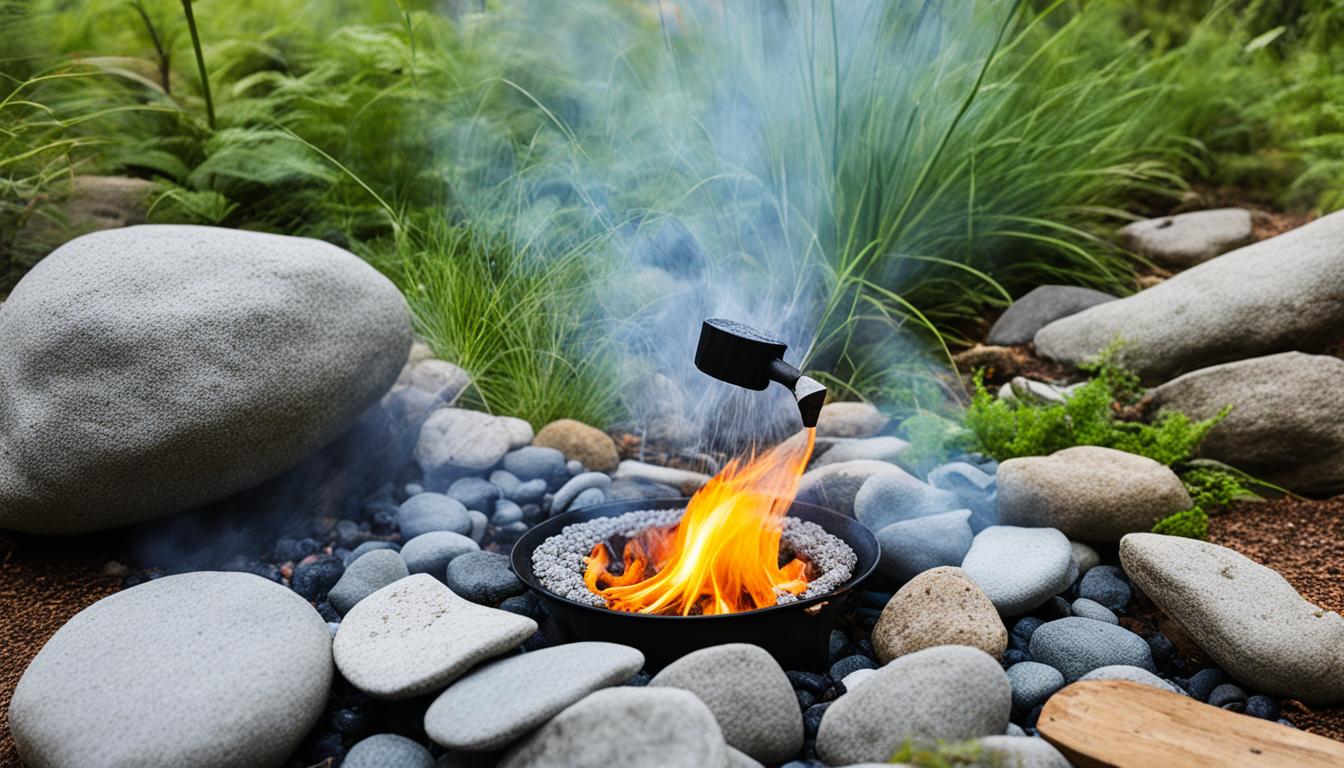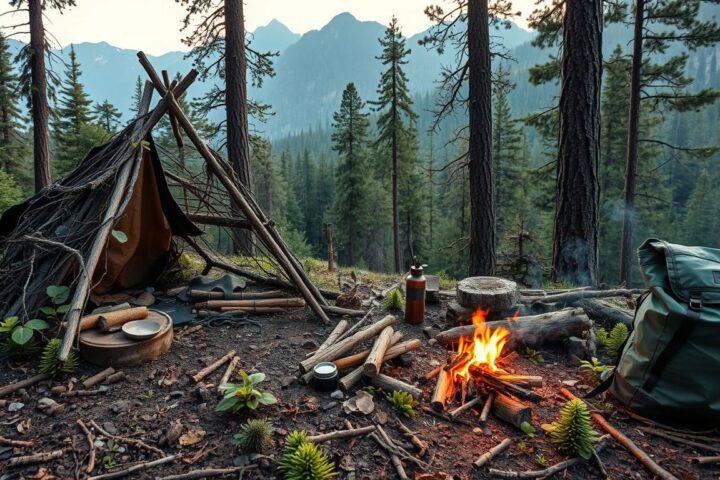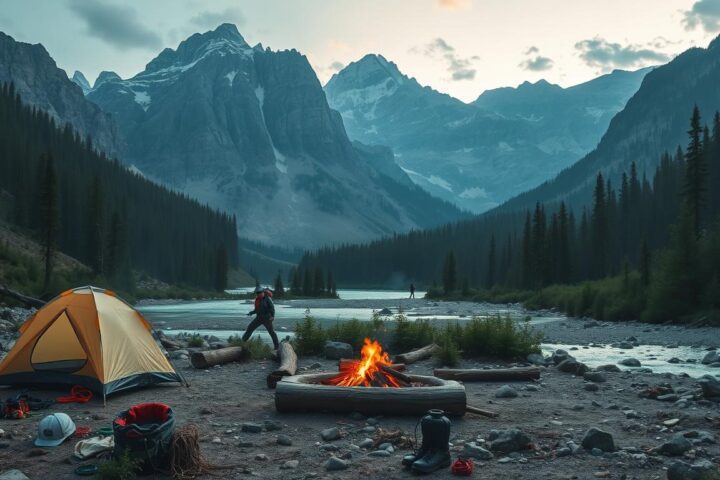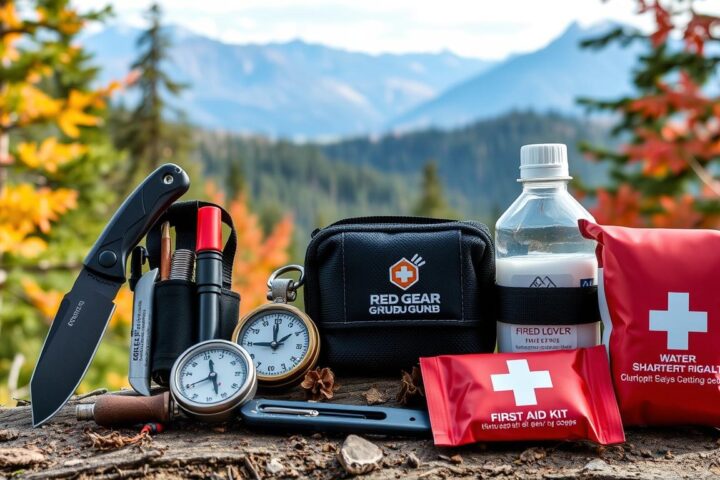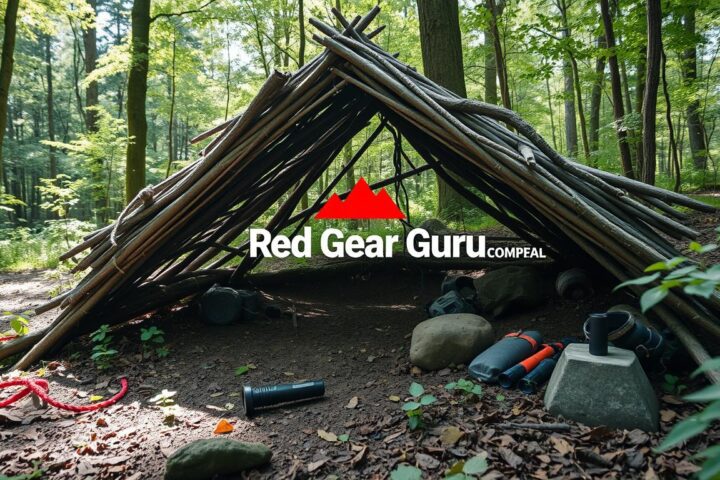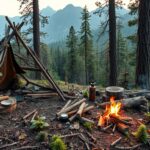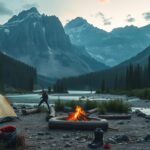Finding clean, drinkable water is crucial in a survival situation. Without it, you won’t last more than three days. This guide will show you how to keep your water safe and clean in the outdoors.
We’ll cover everything from portable filters and boiling to tablets and solar disinfection. These methods help purify water in the wild. Whether you’re hiking, camping, or lost, knowing these techniques can save your life. Let’s dive into how to purify water in the wild and overcome survival challenges.
The Importance of Clean Drinking Water in Survival Situations
In a survival crisis, finding and purifying enough drinking water is key. The human body can only last three days without water. Depending on where you are and the situation, water might be easy to find or hard to get.
Being stranded in the desert or facing a disaster at home, having a way to make water safe is vital. Staying hydrated keeps you healthy and strong in the wilderness. Your body needs at least two quarts of water daily for good health.
Not having enough water can lead to dehydration in just six hours. Drinking contaminated water is dangerous and can cause illnesses. These illnesses can make you very sick and weaken your survival chances.
Diseases like dysentery, cholera, and giardiasis can make you very ill in a survival situation. They cause diarrhea, vomiting, and can lead to dehydration. Having safe, clean water is key to staying healthy and surviving.
- The human body can only survive about three days without water.
- Severe dehydration can start in as little as six hours without water.
- Drinking contaminated water can lead to water-borne illnesses that compromise survival.
- Waterborne diseases like dysentery, cholera, and giardiasis can quickly debilitate an individual.
- Maintaining health with safe, purified water is crucial for survival.
Finding Water Sources in the Wild
Staying hydrated is key to surviving in the wilderness. There are many ways to find and use water to stay thirsty. You can look for surface water like streams, creeks, ponds, and lakes. But, make sure to purify it before drinking.
Precipitation, like rain, snow, sleet, hail, and dew, can also be used for water. Fresh rain that hasn’t touched the forest canopy is usually safe to drink. Underground sources like springs and seeps can also give you clean water. But, other sources need to be cleaned before you drink them.
- Streams, clear flowing water, and small streams are good for finding water in the wild. But, bigger rivers might be polluted from upstream.
- Rainwater collection is a safe way to get water, especially in rural areas.
- Morning dew collection can give you up to a liter of water per hour.
- Plants like fruits, vegetables, roots, and cacti can help you stay hydrated when water is hard to find.
- An underground still can give you a steady water supply, making about 0.5-1 liter per day.
- In cold or snowy places, melting snow and ice can be used for water. But, always melt and purify it first.
- In deserts, finding water is tough. Look for wells in damp or green areas.
Knowing where to find water in the wilderness and purifying it is important. This way, you can have a steady supply of clean drinking water for your outdoor trips.
Boiling Water for Purification
Boiling water is a top choice for making it safe to drink in the wild. It kills harmful parasites, bacteria, and other pathogens. This method is safe, even if it doesn’t remove all chemicals.
To kill all germs, boil the water for at least five minutes. But boiling for 10 minutes is even safer. Remember, high places can change how water boils, so adjust the time if you’re up high.
You can boil water over a campfire, stove, or by heating rocks and putting them in your water. This trick is great if you don’t have a special container for boiling in the wild.
Boiling water is easy and effective for making it safe to drink. It’s a key step for staying safe on any adventure.
Using Purification Tablets or Drops
In the wild, using water purification tablets and drops can make dirty water safe to drink. Katadyn’s Micropur tablets and Potable Aqua’s iodine tablets are popular choices. They kill over 99% of harmful germs in water, making them a trusted way to purify water.
Potable Aqua’s iodine tablets last a year, and Katadyn Micropur tablets can last two years or more. Potable Aqua’s tablets make water safe to drink in 35 minutes, while Micropur takes four hours. But, some people might not like the taste of Potable Aqua’s iodine. This includes pregnant women, people with thyroid problems, or those allergic to shellfish.
When picking purification chemicals, think about their effectiveness and any downsides like bad taste or toxicity. It’s key to use the right amount and wait the right time. This ensures the water purification tablets and drops kill all harmful germs.
Chemical disinfection methods are great for survival, but know the considerations for using purification chemicals. Pick the best option for your needs and what you prefer.
Water Distillation Methods
In survival situations, water distillation is a safe and effective way to purify water. It heats water to steam, then captures and condenses it to make clean water. This method works well even if the water is polluted.
Distillation removes many contaminants, like heavy particles and microbes. For disaster preparedness at home, you can make a simple water distiller with a pressure canner and copper tubing. In the field, an improvised solar still uses a clear plastic sheet over a hole, with a container to collect the distilled water.
If you’re dealing with questionable or contaminated water, distillation is key. It removes impurities, making clean drinking water available in survival situations. This method is simple yet effective, offering a reliable way to purify water when other options fail.
water purification in the wild
Staying hydrated is key in survival situations, but finding clean drinking water can be tough. When you’re in the wilderness, having a plan for water purification is crucial. You can use boiling, purification tablets, or even make your own filters to keep your water safe.
Creating a basic survival water filter with pebbles, sand, and charcoal is a good idea. Charcoal filters are great because they remove sediment and contaminants and can make the water taste better. To make a charcoal filter, just build a campfire, cover it with dirt and ash, and let it cool down completely.
High-quality water filters are best, but they might not always be around in remote places. Knowing backcountry water treatment methods and off-grid water cleaning solutions can save your life. Boiling, using purification tablets or drops, and distilling water are all ways to make sure your water is safe.
Being prepared is the key to staying hydrated and healthy in the wild. Always carry different water purification techniques for wilderness with you. Learn about these methods and practice them. This way, you’ll always have access to clean, safe drinking water, no matter where you go.
Utilizing Plants for Water Purification
Plants are a great way to naturally purify water in the wild. Some plants can remove harmful contaminants, making them key in survival. By using plants to purify water, we can find clean drinking water in the wilderness.
There are many plants that help purify water. Floating aquatic plants like azolla and duckweed are top choices for cleaning wastewater. They take out nitrogen and phosphorus, making the water safer. Reeds, including cattails, bulrushes, and papyrus, are also great. They filter out excess nutrients and toxins from the water.
But there are even more plants that can clean water. Cilantro, rice, and coconuts can remove harmful substances from water. Fruit peels and shrubs like the Oregon Grape have special properties too. The inner bark of the Oregon Grape has berberine, which fights off bacteria and purifies water.
Looking for plants to purify water in the wild is easier than you think. Nature offers many options, from aquatic plants to trees. By using these natural filters, we can make sure we have clean drinking water in tough situations.
Improvised Water Filtration Systems
In a survival situation, having clean drinking water is key for staying hydrated and healthy. While commercial filters are great, you can also use natural materials to make your own. These methods can help remove debris and make the water taste better.
To filter water, you need to get rid of big particles like dirt and sticks. Use pebbles, sand, cloth, and activated charcoal to make a filter. Put these materials in a container and pour water through to clean it.
You can make a simple filter with a 2-liter bottle, a knife, and some natural stuff. Start with pebbles or gravel at the bottom, then add coarse and fine sand, and finish with activated charcoal. This way, the water gets cleaner as it goes through each layer.
Instead of bottles, you can use bamboo or a hollow log for your filter. Try different materials and setups to see what works best for you.
These DIY filters can make your water safer, but they might not catch all harmful stuff. Always boil or disinfect the water to make sure it’s safe to drink.
Sedimentation for Clearing Murky Water
Dealing with murky water in survival situations can be tough. Sedimentation is a simple yet effective way to clear it up. By letting the water sit still, particles and sediments will settle at the bottom. This leaves the clear water on top.
To purify water using sedimentation, follow these steps:
- Collect the water in a separate container, being careful not to disturb the water’s surface and mix the sediments back in.
- Allow the water to sit undisturbed for several hours, or even overnight if possible.
- Gently scoop or pour the clear water from the top of the container, leaving the settled particles at the bottom.
This method of sedimentation for water purification is great for clearing muddy water through settling and removing particulates. By letting particles settle, you can separate clean water from the murky part. This makes purifying the water easier with methods like boiling or filtration.
Remember, the key to successful sedimentation is to avoid disturbing the water. Gently scooping or pouring the clear water from the top helps keep the sediments at the bottom. With patience and this simple method for removing particulates, you can make your water supply safer in the wild.
Solar Water Disinfection (SODIS)
Finding clean drinking water in survival situations is crucial. Solar water disinfection (SODIS) is a simple way to purify water using the sun. It involves putting contaminated water in clear plastic bottles and leaving them in the sun for a day. This method kills harmful germs with the sun’s UV rays.
SODIS is easy to use and doesn’t cost much. It can kill many germs and viruses. But, it has some downsides. It needs the sun or two cloudy days to work well. It can’t be used when it’s raining, doesn’t keep water clean after treatment, and might not work on all germs. It’s best for small amounts of water, like in bottles or bags.
Despite its limits, SODIS has been well-studied and proven effective. According to McGuigan et al. (2012), it’s a promising way to purify water. It has been shown to protect against diseases like cholera in kids and prevent diarrhea in many places.
In summary, SODIS isn’t perfect for all water needs, but it’s useful. By knowing its pros and cons, people who love the outdoors can use it to get clean water in tough places.
Ultraviolet Light Disinfection Methods
UV light is a top choice for purifying water in the wild. It damages the DNA of small organisms, killing microbes that cause illness. Tools like the [http://tac.tui.mybluehost.me/10-facts-about-the-attempted-assassination-of-president-trump/ Steripen Sidewinder] are simple to use. They kill pathogens in seconds without batteries.
For a modern touch, there are battery-powered [http://tac.tui.mybluehost.me/10-facts-about-the-attempted-assassination-of-president-trump/ Steripen products]. They use UV light to kill bacteria, viruses, and protozoa in water.
But, UV light doesn’t work well on water with big particles. Pathogens can hide behind these particles, avoiding the UV light. So, it’s best to use UV light on clear water only.
UV light is a great way to purify water when you’re outdoors. These devices are light and easy to carry. They’re perfect for hikers, campers, and anyone who needs safe drinking water.
Conclusion
This article covered key water purification methods for safe drinking water on outdoor trips and in survival situations. You learned about boiling, using tablets or drops, distillation, plants, and making your own filters. Now, you can clean water in the wild and avoid dehydration.
Even with these methods, getting sick is still possible. Always see a doctor if you’re worried about the water you drank. Stay hydrated and ready, and you’ll do well in nature. With these water purification tips, you can make sure your water is safe and avoid getting sick while enjoying the outdoors.
Learning these water purification techniques gives you the skills to handle any survival situation. They are crucial for hiking, camping, or emergencies. Use these methods to make sure your water is safe. Now, you can go on your outdoor adventures with confidence.
